INTRODUCTION OF MORPHOLOGY OF FLOWERING PLANT
- Angiosperms show a large diversity in morphology. Possibly the variation in different parts are due to the adaptions to various habitats.
- Morphology of flowering plant has root system and shoot system.
MORPHOLOGY OF FLOWERING PLANT- THE ROOT
- Elongation of radicle form primary morphology of flowering plant
- Primary root bears lateral roots of several orders that are referred to as secondary, tertiary etc. root.
- Types of roots:-
- (i) Tap root system: Includes primary root and its branches.
- Seen mainly in dicots eg. Mustard.
- (ii) Fibrous root system: In monocot, primary root is short lived and replaced by a large number of roots originate from the base of the stem.
- Aventitious roots: Roots that arise from parts of plants other than radicle eg. Monstera and banyan tree.
- Function of roots:-
- Absorption of water and minerals from soil.
- Provide anchorage to plant parts.
- Storage of reserve food materials.
- Synthesis of plant growth regulators (PGRs).
REGIONS OF ROOT
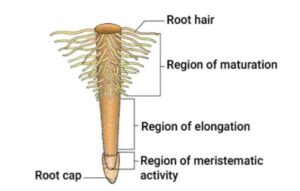
MODIFICATION OF ROOT
Storage of food
- Tap root-Carrot, turnip
- Adventitious root -Sweet potato
Prop root
- Arise from branches to support them
- eg.Banyan
Stilt root
- Supporting root coming out from lower nodes
- eg. Maize, sugarcane
Pneumatophore
- Root growing vertically upward for oxygen in plants of swampy area
- eg. Rhizophora
MORPHOLOGY OF FLOWERING PLANT- THE STEM
- Develops from plumule
- Bears nodes , internodes ,buds (terminal or axillarry).
Functions:
- Spread out branches bearing leaves ,flowers,fruits.
- Conducts water ,minerals and photosynthates
MODIFICATIONS OF STEM
Underground stem:- For storage of food, also act as organ of perennation to tide over conditions unfavourable for growth. e.g. potato, ginger, turmeric, Clolocasis, Zaminkand.
- Tendrils:- Axillary bud may modify into tendril, help plants to climb.
eg Grapevines and Gourds (Cucumber, Pumpkin, Watermelon).
- Thorn:- Axillary buds modify into woody pointed thorn eg Bougainvillea, citrus.
- flat or cylinndrical photosynthetic stem: eg. Opuntia (flattened), Euphorbia (cylindrical)
SOME OTHER MODIFICATIONS OF STEM
- In mint and jasmine a slender lateral branch arise from base of the main axis and after growing aerially arch downward and touch the ground.
- Aquatic plants like Pistie and Eichhormia have lateral branch with short intermodes and node bear rosette of leaves and tuff of roots.
- In banana, pineapple and Chrysanthemum lateral branches arise from basal and underground stem, grow horizontally and then come out obliquely upward to form leafy shoots.
- Underground stem of grass and strawberry spread to new niches and when older part dies new plants are formed. Underground storage stem also acts as organ of perrenation.
MORPHOLOGY OF FLOWERING PLANT- THE LEAF
- Lateral generally flat structure, develops at node and bear a bud in its axil.
- Arise from ahoot apical meristem and arranged in acropetal order.
- Consist of 3 parts, leaf base, petiole and Lamina.
- Two lateral small leaf like structure at base, are called stipules.
- Leaf basemay expand into sheath like structure covering stem partially or wholly in monocots.
- Leaf base may become swollen in leguminous plants called pulvinus
TYPES OF LEAVES
- SIMPLE LEAF: Lamina is entire or when incised, incision do not reach midrib.
- COMPOUND LEAF: Incision of lamina reaches up to the midrib breaking it into laeflets. It is of two types.
- (i) Pinnately compound-leaflets are present on a common axis, the rachis. eg Neem
- (ii) Palmatey compound-leaflets are attached at a common point i.e at the tip of petiole. eg silk cotton
.
LEAF
- VENATION:-
(I) Reticulate :-
- Veinlets form network
- eg. generally in dicots
(ii) Parallel:-
- Veins run parallel to each other
- eg. most monocots.
2. PHYLLOTAXY:-
(I) Alternate: Single leaf at each node arranged in alternate manner eg. china rose, mustard, sunflower
(ii) Opposite: Pair of leaves arise at each node eg. Guava, Calotropis
(iii) Whorled: More than two leaves arise at each nodes eg. Alstonia.
3. MODIFICATION OF LEAVES:
- Tendril eg. Pea
- In Australian Acacia petiole expands and become photosynthetic
- Spines eg. Cacti ( for defence)
- Fleshy leaves for storage eg. Onion, Garlic
- For traping insect eg venus-fly trap, pitcher plant (insectivorous plant).
MORPHOLOGY OF FLOWERING PLANT- THE FLOWER (REPRODUCTIVE UNIT)
FLOWER
Symmetry:-
(i) Actinomorphic (Radial symmetry):- Flower can be divided into two equal halves in any plane passing through centre eg. chilli, mustard and Datura.
(ii) Zygomorphic (Bilateral symmetry):- Flower can be divided into two similar halves only in one particular vertical plane eg. Pea, bean, Cassia, Gulmohur.
TYPES-
Unisexual:- Flower either have androecium or carpels.
Bisexual:- Flower have both stamens and carpels.
Trimerous:- Floral appendages are multiple of 3.
Tetramerous:- Floral appendages are multiple of 4.
Pentamerous:- Floral appendages are multiple of 5.
Hypogynous:-
- Gynoecium occupies highest position, other parts are situated below it.
- Superior ovary
Eg. BMC:- Brinjal-Mustard-China rose.
Perigynous :-
- Gynoecium situated in centre, other parts located at the rim of thalamus.
- Ovary half inferior
Eg. 2PR:- Pulp-Peach-Rose.
Epigynous:-
- Margin of thalamus grows upward enclosing ovary comletely and get fused with it. Other parts arrise above the ovary.
- Ovary inferior
Eg. Guava, Cucumber and ray florets of sunflower.
MORPHOLOGY OF FLOWERING PLANT- THE INFLORESCENCE
- Flower is a modified shoot.
- During flowering:-
(i) Shooting apical meristem modifieds into floral meristem
(ii) Internode do not elongate and axis gets condensed.
- Sollitary flower:- Shoot tip transforms into a flower
- Arrangement of flowers on floral axis is called inflorescence.
Two major types:-
(i) Racemose:-
- Main axis continues to grow.
- Flowers borne laterally in acropetal succession.
(ii) Cymose:-
- Main axis terminates into a flower (limited growth)
- Flowers borne in basipetal succession.
PARTS OF A FLOWER
(I) CALYX:-
- Outermost whorl
- Members called sepal
- Protect flower in bud stage
- Generally green
MAY BE
- Gamosepalous (sepals united)
- Polysepalous (sepals free)
(ii) COROLLA:-
- Members called petals.
- Brightly coloured.
MAY BE
- Gamopetatous (petal united)
- Polypetalous (petals free).
(III) ANDROECIUM:-
- Composed of stamens.
- stamens consist of filament +anther.
- Each anther is bilobed and each lobe has two chambers.
- Sterile stamen-Staminode
- Male reproductive part
(IV) GYNOECIUM:-
- Made of one or more carpels
- Carpels consist of stigma style and ovary
- each ovary bears one or more ovules attached to a flat cushion like placenta.
- Carpeks may be free , apocarpous (eg. lotus, rose) or united, syncarpous (tomato,mustard).
- When calyx and corolla are not distinct termed as perianth (unit tepal) eg. lily.
- Mode of arrangement of sepals or petals in floral bud w.r.t. other members of the same whorl.
TYPES
(I) VALVATE:-
- Sepale/petals in awhorl just touch one another at the margin without overlapping eg. Calotrpis.
(ii) TWISTED:-
- One margin of the appendage overlaps the next one and so on.
- eg. china rose, lady’s finger & cotton.
(III) IMBRICATE:-
- Margins of sepals or petals overlap one another but in any particular direction.
- eg. Cassia, gulmohur.
(IV) VEXILLARY:-
- Five petals , one largest (Standard) overlaps two lateral petals (wings) which in turn overlap two smallest anterior petals (keel)
- eg. Pea,bean.

MORPHOLOGY OF FLOWERING PLANT- STAMEN
(I) ATTACHMENT WITH OTHER FLORAL WHORL:-
- Attachment with petals epipetalous (brinjal)
- Attachment with perianth epiphyllous (lily)
(ii) ATTACHMENT WITH EACH OTHER:-
(a) Free↔ polyandrous
(b) United with each other in one bundle
Monadelphous eg. China rose
(c) United in two bundles
Diadelphous eg. pea in
(d) United in more than two bundles- polyadelphous.
MORPHOLOGY OF FLOWERING PLANT- PLACENTATION
Arrangement of ovules within the ovary.
TYPES
(I) MARGINAL:-
- Placenta forms a ridge along ventral suture of ovary and ovules are borne on it forming two rows eg. pea
(ii) AXILE:-
- Placenta axial ovules attached on it in a multiocular ovary. egg. china rose, tomato, lemon.
(iii) PARIETAL:-
- Ovules develop on inner wall of ovary or on peripheral part. Ovary is one chambered due to false septum eg. Mustard, Argemone.
(IV) FREE CENTRAL :-
- Ovules are borne on central axis and septa are absent eg. Primrose, Dianthus.
(v) BASAL:-
- Placenta develops at the base of ovary and a single ovule is attached to it eg. Sunflower, Marigold.
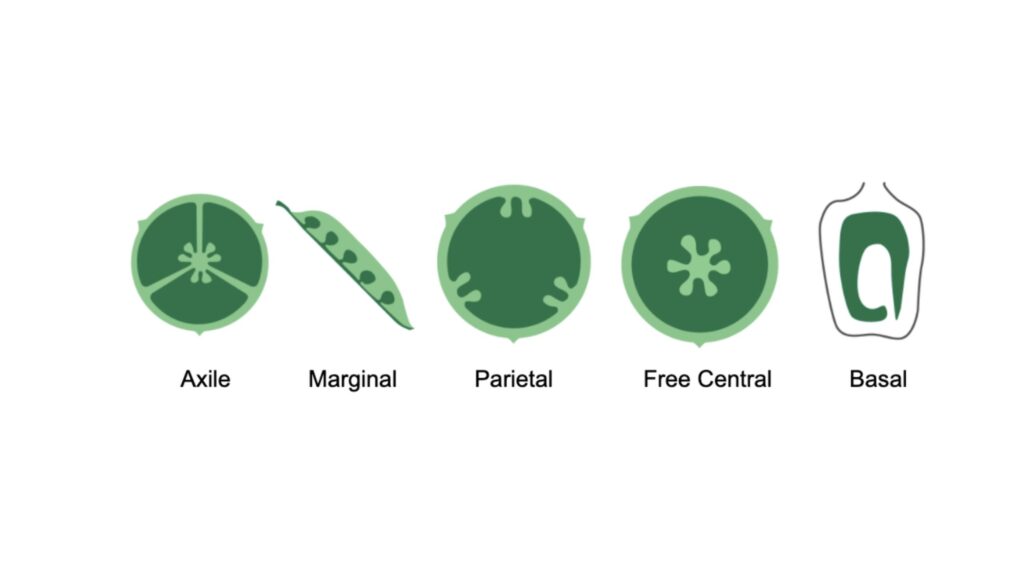
THE FRUIT AND SEED
OVULE:↔(After fertilization)
- Turn into seed→ Consists of
(i) Seed coat (Testa, tegmen)
(ii) Embryo.
OVARY:-
- Ripens into→Fruit
Consists of ↔
(i) Seeds.
(ii) Pericarp→ May be dry or fleshy↔Divided into
(a) Epicarp (b) Mesocarp (c) Endocarp
- Fruit formed without fertilization is called parthenocarpic fruit.
- Mango and coconut are dupe type of fruits, develop from manocarpellary superior ovaries and are one seeded. In mango, mesocarp is fleshy edible and in coconut it is fibrous. Both have hard stony endocarp.
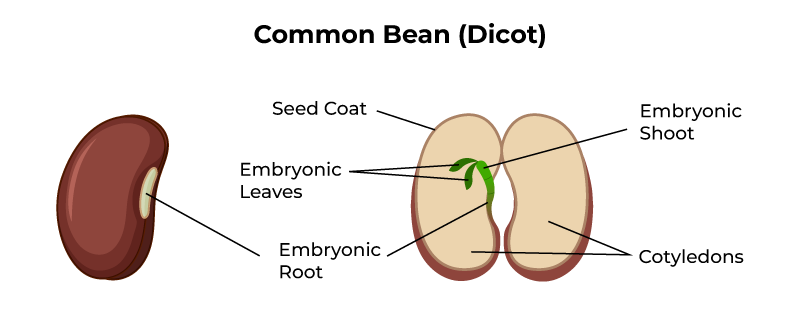
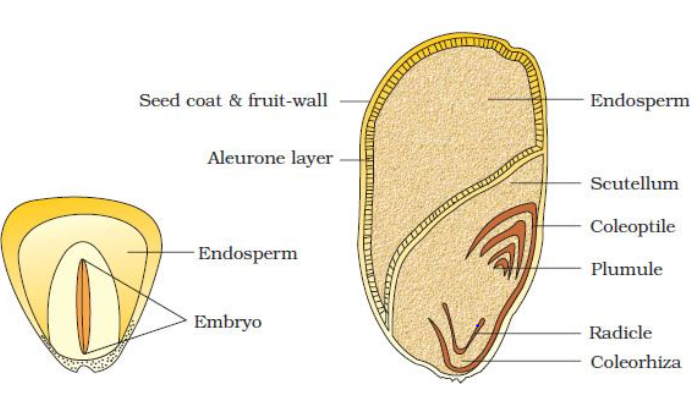
DESCRIPTION OF SOME IMPORTANT FAMILIES
Character/feature Fabaceae
- Stem Erect or climber
- Leaves Alternate, pinnately compound pulvinate, stipulte,venapionreticulate
- Inflorescence Racemose
- Flower Bisexual , Zygomorphic aestivation
- Calyx 5, gamosepalous, Valvate/Imbricate aestivation
- Corolla 5, Polypetalous, papilionaceous corolla, Vexillary aestivation
- Androeciun 10, Diadelphous,anther, bithecus
- Gynoecium Superior ovary, monocarpellary, uilocular, many ovules,marginal placentaion
- Fruit and seed Legume, non-endospermic seed
- Floral fomula % bysexual K (5) C 1+2+(2) A (9)+1_G1
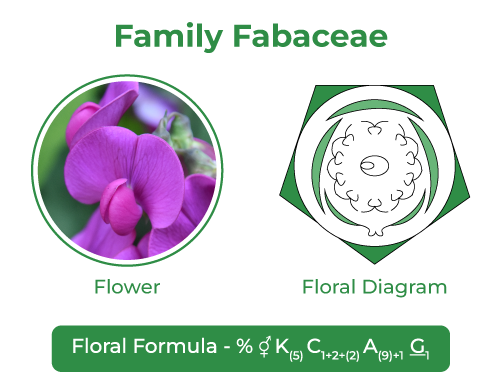
Character/Feature Solanaceae
- Stem Herbaceous, rarely woody solid/hollow, hairy/galbrous, underground as in potato.
- Leaves Alternate, simple rarely pinnate, reticulate venation
- Inflorescence solitary, axillary or cymose as in solanum
- Flower Bisexual, actinomorphic
- Calyx 5, Gamosepalous, persistent, valvate aestivation
- Corolla 5, Gamosepetalous, valvate aestivation
- Androecium 5, epipetalous
- Gynoecium Bicarpellary, obliquely placed, Syncarpous, superior, bilocular, placenta swollen, axile placentation, many ovules
- Fruit and seed Berry/capsule, endospermous seed
- Floral formula ⊕ bisexual K(5) C(5) attached to A5 _G(2)
- Floral diagram
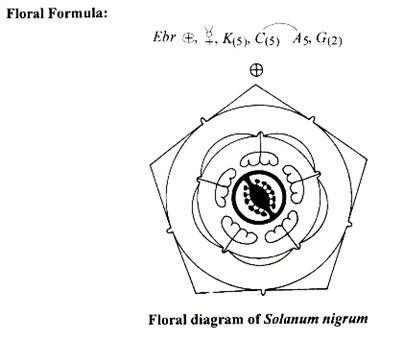
- Leave– mostly basal, alternate, linear, exstipulate, parallel venation
- Stem– underground bulbs/ corns/ rhizome
- Inflorescence: Cymose- solitary; umbellate clusters.
- Flower: Complete, bisexual, actinomorphic; hypogynous, perianth present.
- Perianth: Indistinctive sepal and petal; six tepals (3+3), often united tepals; valvate aestivation.
- Androecium: Six stamens in two whorls (3+3).
- Gynoecium: Syncarpous, tricarpellary, trilocular, superior ovary with axile placentation.
- Fruit: Mostly Capsule and sometimes berry.
- Seed: Endospermic seeds.
- Floral formula: Br⊕ bisexual P(3+3) attached to A(3+3) _G(3)
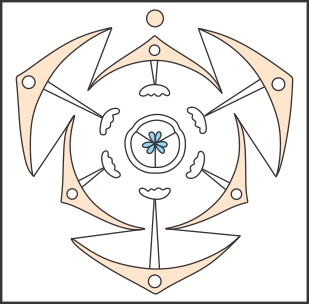
ECONOMIC IMPORTANCE
FABACEAE
- pulses(gram.arhar,sem,moong,soyabean)
- Edible oil (soyabean,groundnut)
- Dye(indigofera)
- Fibres( sunhemp)
- Fodder(sesbania,trifolium)
- Ornamental (lupin, sweet pea)
- Medicine(muliathi)
SOLANACEAE
- Food– (tomato, potato, brinjal)
- Spice– (chilli)
- Medicine- ( belladonna, ashwagandha)
- Fumigatory– tobacco
- Ornamental– Petunia
LILACEAE
- Vegetable– (Asparagus)
- Medicine– (Aloe)
- Ornamental– (Tulip, Gloriosa)
- Colchicine- (colchicum autumnale)
SEMI TECHNICAL DESCRIPTION OF TYPICAL FLOWERING PLANT
A. Symbols used in floral formula:
- Calyx- K
- Corolla- C
- Perianth- P
- Androecium- A
- Gynoecium- G
- Superior ovary- _G
- Inferior- -G
- Male flower- male
- Female flower- female
- Bisexual- bisexual
- Actinomorphic- ⊕
- Zygomorphic- %
- Floral formula of mustard ⊕bisexual K2+2 C4 A2+4 _G(2)
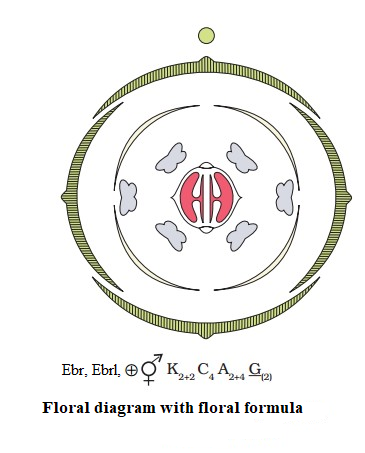
- Fun fact: Did you know that the “morphology of flowering plants” reveals nature’s artistry, from the intricate patterns of petals to the hidden wonders of underground roots?
- Fun fact: Within the captivating realm of morphology of flowering plants, lies a world of botanical marvels, where petals mimic nature’s brushstrokes and leaves tell tales of adaptation and resilience.
- Fun fact: In the study of morphology of flowering plants, we discover nature’s creativity—where stamens and pistils play a botanical dance, and each petal and leaf holds a unique story of evolution and adaptation.
Morphology refers to the study of the form, structure, and external features of plants, including their roots, stems, leaves, flowers, and fruits.
The main parts of a flowering plant include roots, stems, leaves, flowers, and fruits. Each part has specific functions in the plant’s growth, development, and reproduction.
Roots anchor the plant in the soil, absorb water and minerals from the soil, and provide support for the aboveground parts of the plant. They also store nutrients and carbohydrates.
Stems can be classified into various types based on their structure and function, including herbaceous stems (soft and flexible) and woody stems (hard and rigid). Stems serve as conduits for water, nutrients, and photosynthetic products, and they provide support for leaves and flowers.
Leaves are the primary sites of photosynthesis, where plants manufacture carbohydrates using sunlight, carbon dioxide, and water. They also regulate transpiration, exchange gases with the atmosphere, and provide a surface area for gas exchange and light absorption.